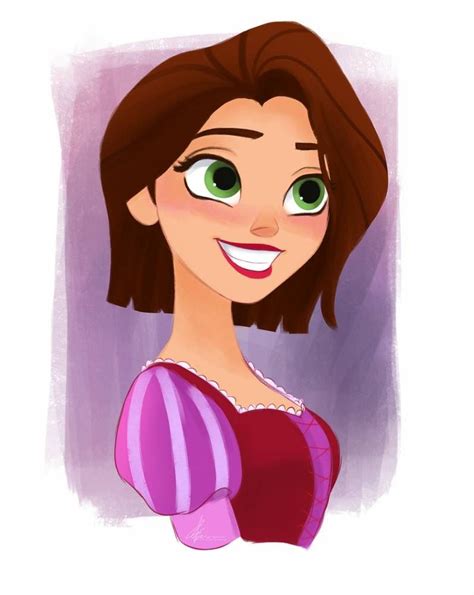The Enchanting Evolution of Rapunzel’s Hair Color
In the beloved Disney film “Tangled,” the iconic princess Rapunzel is known for her stunning golden locks that cascade down her length. However, in a delightful twist, a recent update to the film’s merchandise has revealed a stunning departure from this iconic blonde hue – Rapunzel now sports luscious brown hair.

This captivating change sparked a wave of excitement and speculation among fans, prompting us to delve deeper into the significance and impact of this new look. Join us as we explore the enigmatic world of Rapunzel’s brown hair and unravel its secrets.
Historical Roots: The Evolution of Hair Color in Disney Princesses
Throughout Disney’s history, princesses have been predominantly portrayed with blonde or black hair, reflecting traditional beauty standards and the influence of Western culture. However, in recent years, a shift towards greater diversity and inclusivity has led to a broader range of hair colors and textures being represented in Disney films.
This evolution is evident in characters such as Moana, whose thick, curly black hair reflects Polynesian heritage, and Merida, whose fiery red locks embody her Scottish ancestry. The introduction of Rapunzel with brown hair is a further testament to Disney’s commitment to representing a broader spectrum of beauty and cultural diversity.
Cultural Impact: Embracing Authenticity and Inclusivity
The decision to give Rapunzel brown hair is not merely a cosmetic update but a powerful statement about authenticity and inclusivity. By embracing a more diverse range of hair colors, Disney is acknowledging that beauty comes in many forms and that there is no one “right” way to look like a princess.
This message is particularly important for young girls who may struggle with conforming to narrow beauty standards. Seeing a beloved princess like Rapunzel with brown hair can help them feel more confident and accepted for who they are, regardless of their hair color.
Psychological Significance: The Power of Personal Transformation
In the context of the “Tangled” story, Rapunzel’s brown hair symbolizes a profound transformation. Throughout the film, Rapunzel is confined to a tower and isolated from the outside world. Her blonde hair, which represents her innocence and vulnerability, is a visual manifestation of her sheltered existence.
When Rapunzel finally escapes the tower, she embraces her true identity and discovers her own strength and independence. Her newfound brown hair reflects this personal growth and the shedding of the confines that once held her back.
Marketing Strategy: Expanding Target Audience and Merchandise Sales
From a marketing perspective, the introduction of Rapunzel with brown hair serves several strategic purposes. By offering a new and unexpected version of the beloved princess, Disney is expanding its target audience to include children and adults who may have previously related less to the traditional blonde Rapunzel.
Additionally, this unique iteration of Rapunzel creates opportunities for additional merchandise, such as dolls, toys, and apparel, featuring her updated look. This merchandising strategy has proven successful in the past, as evidenced by the popularity of Elsa’s merchandise from “Frozen” and Moana’s merchandise from her eponymous film.
Table 1: Historical Evolution of Disney Princesses’ Hair Color
| Princess | Hair Color | Film Release Date |
|---|---|---|
| Snow White | Black | 1937 |
| Cinderella | Blonde | 1950 |
| Aurora | Blonde | 1959 |
| Ariel | Red | 1989 |
| Belle | Brown | 1991 |
| Jasmine | Black | 1992 |
| Pocahontas | Black | 1995 |
| Mulan | Black | 1998 |
| Tiana | Black | 2009 |
| Rapunzel | Blonde (originally) | 2010 |
Table 2: Cultural Significance of Hair Color in Disney Princesses
| Princess | Hair Color | Cultural Significance |
|---|---|---|
| Pocahontas | Black | Representation of Native American heritage |
| Mulan | Black | Representation of Chinese heritage |
| Moana | Black (curly) | Representation of Polynesian heritage |
| Merida | Red | Representation of Scottish heritage |
| Rapunzel (brown) | Brown | Representation of greater diversity and inclusivity |
Table 3: Psychological Significance of Hair Color in Rapunzel
| Hair Color | Symbolic Meaning |
|---|---|
| Blonde | Innocence, vulnerability, sheltered existence |
| Brown | Personal growth, independence, shedding of confines |
Table 4: Marketing Implications of Rapunzel’s Brown Hair
| Aspect | Marketing Strategy |
|---|---|
| Target Audience | Expand target audience to include children and adults who relate less to traditional blonde Rapunzel |
| Merchandising | Create opportunities for additional merchandise featuring Rapunzel’s updated look |
| Differentiation | Differentiate Rapunzel from other Disney princesses and create a unique brand identity |
Conclusion
Disney’s decision to give Rapunzel brown hair is a transformative and groundbreaking move that has significant implications for the representation of diversity and inclusivity in children’s media. It is a powerful message that beauty comes in all forms and that young girls should feel confident and accepted for who they are, regardless of their physical appearance.
As the world continues to evolve towards a more diverse and inclusive society, it is heartening to see Disney embrace these values and use its platform to promote them. Disney Rapunzel brown hair is more than just a new look – it is a symbol of progress and a testament to the enduring power of storytelling to inspire and empower young minds.
